3 Best Manual Knife Sharpeners of 2024 According to Our Tests
Our kitchen experts have tested 14 manual sharpeners and have identified what tends to make some better than others.

A manual knife sharpener is a handy tool designed to revive the keen edge on your kitchen knives without investing much money, time, and effort. They’re also great for keeping your knives serviceable between deep sharpenings.
While even the best manual knife sharpeners won’t perform to the level of electric ones or whetstones, the right device can deliver reasonable sharpness and a nice, smooth edge.
Our kitchen experts have tested a bunch of manual sharpeners and have identified what tends to make some better than others. Read on to learn how to find a good sharpener. After that, we’ll give you a rundown of our top recommendations.
How We Test
This review article presents the results of 10 months of continuous testing in our lab.
We’ve tested and rated 14 manual sharpeners for Performance, Ease of Use, and Design.
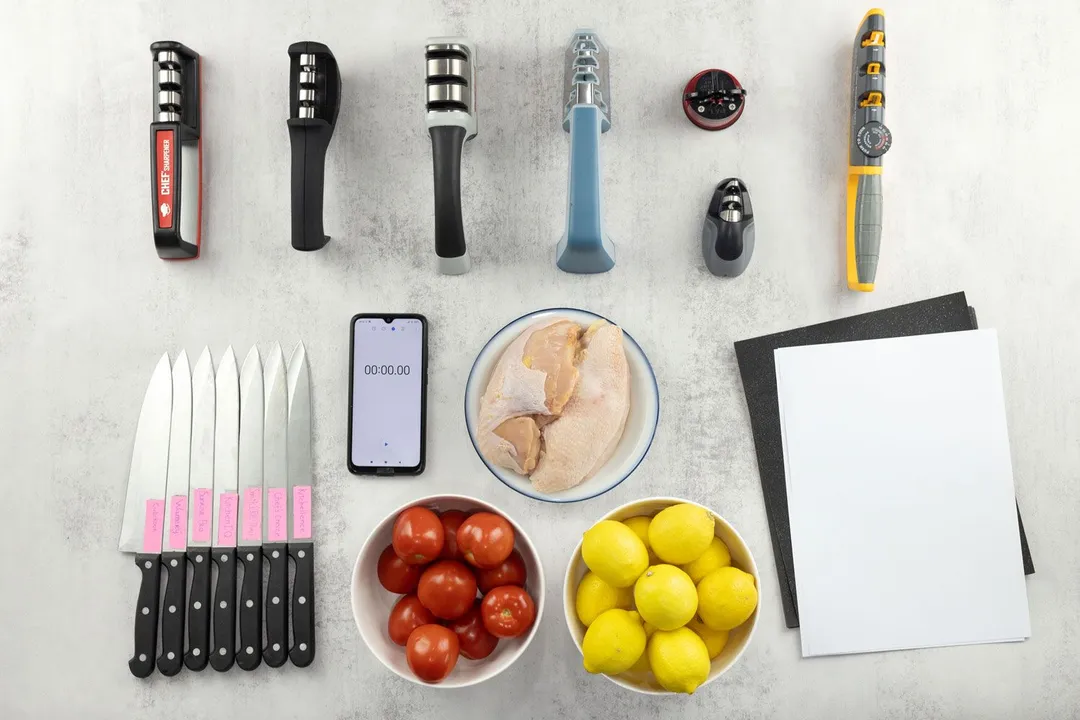
Since pull-through sharpeners are ‘convenience’ sharpeners, speed and sharpness are the most important. As such, these two factors are weighted heaviest among all the test criteria.
For speed, we measure the time it takes for a sharpener to restore a uselessly dull knife to the point that it can slice through a lemon. The maximum level of sharpness, meanwhile, is determined using our Practical Sharpness Scale after 6 minutes of sharpening.
Since we want devices that strike a balance between sharpness and edge integrity, we take into account the smoothness of the completed edge and the amount of metal that got shaved off during the process.
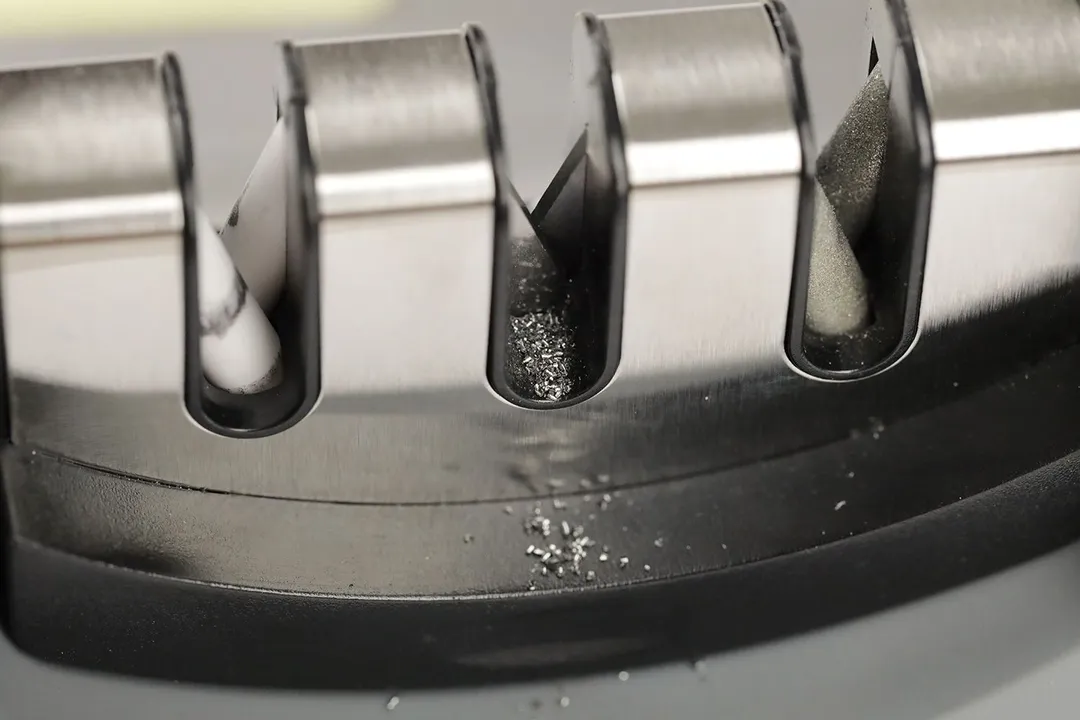
We also evaluate the sharpener’s tabletop stability while we work with it and analyze features that positively or negatively affect its balance. We describe the working section as a whole and try to explain how it feels to sharpen with each device. We want you to understand what it will be like to use each device before you choose which to spend money on.
As with other sharpening devices, we will continue testing new products and update our list of top picks as necessary.
Check out full How We Test Manual Knife Sharpeners for more information.
How Our Recommendations Are Made
Recommendations are based upon the resulting scores of our testing procedures. We take into account the specialized strengths of a product, the situation it’s best suited for, or the personal circumstances it is likely to best match.
Our Top Picks
If you need a quick recommendation of which manual knife sharpener is best for a specific purpose, the list below should help. Here are our picks:
1. Best Overall: Cubikook CS-T01 Knife Sharpener
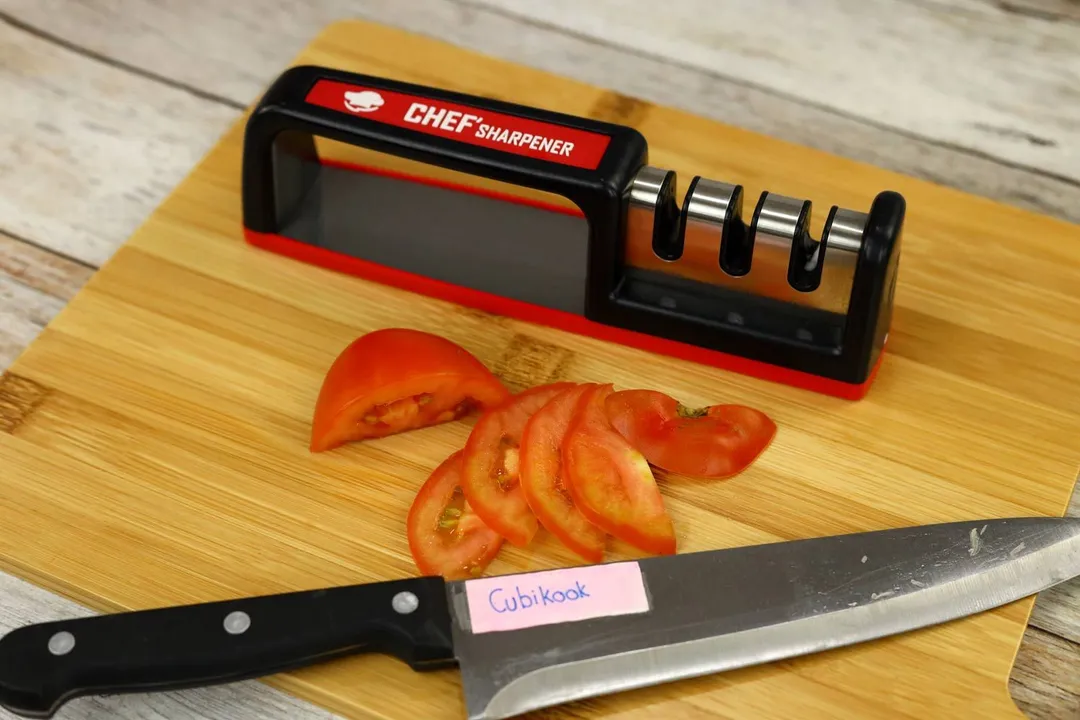
Things We Like
- Excellent stability
- Affordable price
- Consistent sharpness
- Solid and sturdy construction
Things We Don’t Like
- Small ceramic rods
- Flaky brand label
The Cubikook Chef’s Sharpener CS-T01 received the highest overall rating of all the manual pull-through sharpeners we’ve tested so far. It’s fast, effective, and has a design that minimizes the risk of accidents while you’re sharpening. And for all it offers, the price couldn’t be more affordable.
The CS-T01 employs a three-stage sharpening section with diamond-coated abrasive rods, tungsten blades, and ceramic rods, all working at a 20-degree angle. This is one of the most common arrangements among pull-through sharpeners, so there was stiff competition. This Cubikook device rose very neat to the top in both our speed and sharpness test.
It transformed a chef knife from uselessly dull to highly serviceable within 90 seconds, and took only a few more minutes to enable the knife to cut through the slippery skin on a raw chicken breast.
Thanks to a ‘prep’ slot, the sharpener removes very little metal from the knife edge. Its ceramic rods, though modest in size, do a nice job honing the edge to near perfection.
It doesn’t have the most comfortable grip, but with a wide base and modest height, the Cubikook enjoys the great stability granted by its low center of gravity. Its sturdy build and adequate size also contribute to a safe and effortless sharpening experience.
Read our full Cubikook CS-T01 Knife Sharpener in-depth review
2. Runner up: Priority Chef 2-Stage Sharpener
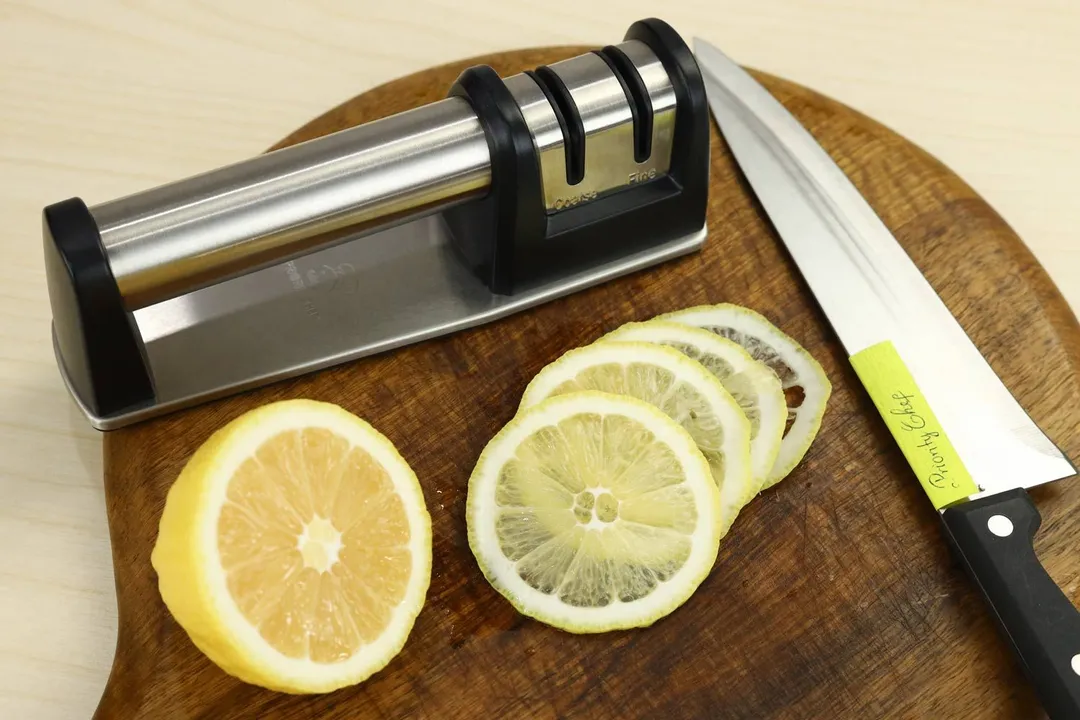
Things We Like
- Modest height, low center of gravity
- Full, flat base
- Gimmick-free design
- Great edge retention
Things We Don’t Like
- Cheap base pad
- Small slot openings
The Priority Chef sharpener may have a modest build, but that doesn’t stop it from placing as one of the top performers in our tests. Its usability and budget-friendly price make it a good choice for first-timers.
The Priority Chef’s working section features wheels rather than rods, but they’re not the motorized type of sharpening wheels. One set of wheels is diamond-coated for sharpening and the other is ceramic for honing your knives. Its grind angle is smaller than most, at 17 degrees.
We’re not sure if it’s the abrasives or the narrow angle, but the sharpener regenerated a dull edge very quickly while barely removing any material from the knife. Its performance in all aspects was far better than the Chef’s Choice 4643, another wheel-based sharpener that costs three times more. In fact, the Priority Chef enjoyed a better performance rating than our Best Buy, the Cubikook!
Similar to the Cubikook, the Priority Chef has a full base and low center of gravity which combine to keep it stable and balanced during sharpening.
However, its build quality isn’t a match. The base and base pad look cheap and shoddy, and its plain stainless steel grip may feel slippery and cold to the touch. Thankfully, the good fundamental design compensates for the materials and you won’t have to worry about the device tipping or wobbling.
Read our full Priority Chef 2-Stage Sharpener in-depth review
3. Best Small: Sunrise Pro Knife Sharpener
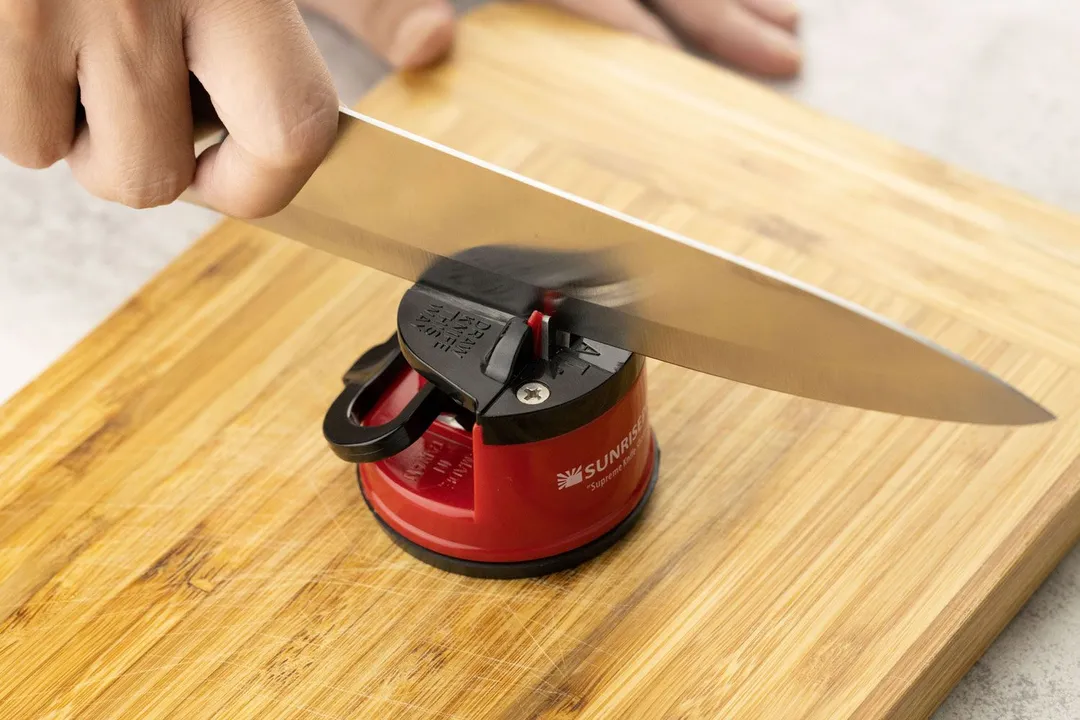
Things We Like
- Strong, sturdy build
- Extremely quick sharpening
- Great sharpness
- Affordable price
- Strong suction base (while it works)
Things We Don’t Like
- Suction base is surface-discriminatory
- It can peel off a lot of metal
Most manual sharpeners don’t have big footprints, but if you’re looking for a particularly small one that works, the Sunrise Pro is worth checking out.
The Sunrise Pro features two tungsten carbide blades that form a 20-degree V-shaped slot. They took just one minute to make a sandpaper-damaged knife sharp enough to slice through a whole lemon. Granted, they shaved much more material off the knife than we’d consider reasonable, but these blades did their job faster than any others we’ve tested so far. Most kitchen knives will be ready within 30 seconds of meeting them.
The sharpener features a suction-cup base, and on the right (flat and clean) surface, it stays firm and stable, allowing you to sharpen without holding it. The device also enjoys a solid construction and sturdy build, despite its low price. And unlike the similarly designed Sharpal, the visual cues on this one make it near impossible to misuse it.
A major weakness, however, is the fact that you need a perfect surface to stick it to—it can be dangerous to sharpen when the suction base does not work. Its tendency to eat away at the knife’s material can also turn some people off. This one is great as a convenient quick-fix sharpener; just don’t rely on it as a long-term maintenance tool for your knives.
Read our full Sunrise Pro Knife Sharpener in-depth review
Things to Keep in Mind When Buying a Manual Knife Sharpeners
After more than 10 months of continuous testing and years of sharpening experience, here’s what we reckon are the most important things to consider when buying a sharpener.
The Abrasives: Material and Layout
The abrasives are what do the work. Nothing can save a sharpener with ineffective abrasives.
Most manual pull-through sharpeners employ one or more sets of sharpening discs, sharpening wheels, crossed rods, and/or crossed blades. On these devices, the grit is a loose term, referred to as ‘Coarse,’ ‘Medium,’ or ‘Fine.’
Crossed abrasive blades, usually made of tungsten carbide, are the most aggressive and can sharpen very quickly because they’re designed to literally shave steel off your knives. The disc, wheel, and rod types, made of ceramic or metal coated with diamond dust, are more edge-friendly, but that doesn’t necessarily mean they’re less effective.
We found that the common abrasive layout—diamond-coated rods for prepping the knife, tungsten carbide blades for sharpening, and ceramic rods for honing—hits the sweet spot in most cases. It’s generally more effective than starting with carbide blades and gentler on the edge than a blades-only layout.
Devices with sharpening discs or wheels are more tricky to choose between—a small detail in the disc design can make a huge difference, and unfortunately the only way to tell is to test them out.
Grind Bevel and Angle
Manual knife sharpeners only sharpen dual-bevel knives, usually at a fixed grind angle. The standard sharpening angle is 20 degrees, which works for most Western knives, but there are also devices made with a smaller angle to accommodate Asian knives.
Some sharpeners, such as the Zwilling 4-stage sharpener or Chef’s Choice 4643, feature separate slots for each type. In rarer cases, such as with the Smith’s Pull-Thru, you can alter the edge angle to suit your knife, but adjustable abrasives can be less steady and thus less consistent.
If your knives are mostly dual-beveled and have roughly the same grind angles, then a good pull-through sharpener with the right angle will handle most of your sharpening tasks.
However, if your collection is a mix of bevel types and edge angles, you’re better off finding a set of whetstones or an adjustable electric sharpener.
Safety Design
The height, width, and length of a device has a significant impact on the sharpening experience.
A device that’s too small will not work for big, heavy knives. Mini sharpeners also tend to cram the grip and working section close together, which translates to a higher risk of cutting yourself if the knife is misplaced during sharpening.
A sharpener that stands high off the table, meanwhile, has a higher center of gravity, making it more prone to tipping. If this height is combined with a long and narrow base, your wrists will get quite the workout trying to keep it balanced.
Pick a pull-through sharpener with a modest height, substantial grip, and a large, wide base with anti-slip pads.
Why Trust Us
We purchase all the products of our own accord and for testing purposes only. We do not procure sponsorship or donations and have no stake in the reputation of the brands.
Our testing procedures are data-driven, transparent, and collaboratively developed. We establish most testing procedures in house, but we consult with outside experts when necessary. Each test is rigorous and transparent; we detail the process, provide the data, and present evidence.
Since we are testing kitchen equipment, we have a team of professional cooks - Tuyet Pham that help us evaluate the results of tests, including taste-testing where necessary.
About your guide
Luna Regina is an accomplished writer and author who dedicates her career to empowering home cooks and making cooking effortless for everyone. She is the founder of HealthyKitchen101.com and HealthyRecipes101.com, where she works with her team to develop easy, nutritious recipes and help aspiring cooks choose the right kitchen appliances.
Anh Ngo is a writer with 9 years experience at different media outlets, covering from public news and events to product testing and analysis. At HealthyKitchen101, she works across different departments, communicating closely with its network of writers, editors, and health, tech, and search engine experts to provide a meaningful and pleasant reading experience for visitors.
Lap is Head of the Research, Testing, and Review Team (RTR Team) at HealthyKitchen101.com, where he directs and supervises the testing of kitchen gadgets and appliances.
Nguyen Ntk is a graphic designer, photographer, and videographer whose philosophy centers around respecting and celebrating the beauty of reality. Through his lenses, Nguyen strives to capture the true essence of objects and events, showcasing and highlighting authentic features without distortion or exaggeration.



